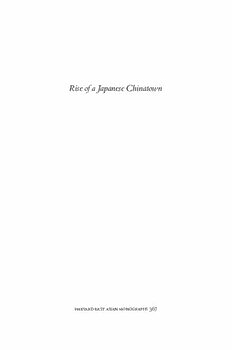
Rise of a Japanese Chinatown: Yokohama, 1894-1972 PDF
Preview Rise of a Japanese Chinatown: Yokohama, 1894-1972
Rise of a Japan ese Chinatown harvard east asian monographs 367 Rise of a Japan ese Chinatown Yokohama, 1894– 1972 eric c. han Published by the Harvard University Asia Center Distributed by Harvard University Press Cambridge (Massachusetts) and London 2014 © 2014 by The President and Fellows of Harvard College Printed in the United States of America The Harvard University Asia Center publishes a monograph series and, in coordination with the Fairbank Center for Chinese Studies, the Korea Institute, the Reischauer Institute of Japan ese Studies, and other facilities and institutes, administers research projects designed to further scholarly understanding of China, Japan, Vietnam, Korea, and other Asian countries. The Center also sponsors projects addressing multidisciplinary and regional issues in Asia. Studies of the Weatherhead East Asian Institute, Columbia University The Studies of the Weatherhead East Asian Institute of Columbia University w ere inaugurated in 1962 to bring to a wider public the results of signifi cant new research on modern and contemporary East Asia. Library of Congress Cataloging-i n-P ublication Data Han, Eric C., 1974- Rise of a Japanese Chinatown : Yokohama, 1894–1972 / Eric C. Han. pages cm. — (Harvard East Asian monographs ; 367) Includes bibliographical references and index. ISBN 978-0-674-49198-4 (hardcover : alk. paper) 1. Chinese—Japan— Yokohama-shi—History—20th century. 2. Yokohama-shi (Japan)— History—20th century. 3. Yokohama-shi (Japan)—Ethnic relations— History—20th century. I. Harvard University. Asia Center, issuing body. II. Title. DS897.Y69C553 2014 305.895'10521364—dc23 2013032677 Index by the author Printed on acid-f ree paper Last fi gure below indicates year of this printing 24 23 22 21 20 19 18 17 16 15 14 For my mother and father Contents List of Figures and Maps ix Ack nowl edgm ents xi List of Abbreviations xv Introduction 1 1 The Sino-J apanese War and Ethnic Unity, 1894– 95 23 2 Expatriate Nationalists and the Politics of Mixed Residence, 1895– 1911 56 3 Cooperation, Confl ict, and Modern Life in an International Port, 1912– 32 90 4 Sino-J apanese War, Sino-J apanese Friendship, and the Yokohama-i te Identity, 1933– 45 124 5 A Town Divided: The Cold War in Yokohama Chinatown, 1945–7 2 157 Conclusion: Minorities in a Monoethnic State and the Micropolitics of Everyday Life 194 Appendix 221 Bibliography 223 Index 239 Figures and Maps Figures 0.1 Xuanwu Gate (Genbumon) 2 0.2 The mild bustle of a weekday even ing in Yokohama Chinatown, March 2005 3 0.3 The Chinese population in Japan, 1890– 1980 10 0.4 The Chinese population of Yokohama, 1890– 1980 11 1.1A-1 .1B The Old Settlement ca. 1894 and Chinatown ca. 1910 32–33 1.2 A 1907 advertisement for Ah Shing’s tailor shop 48 2.1 Datong xuexiao classroom in 1898 64 2.2 Inukai Tsuyoshi and Ōkuma Shigenobu at the Datong xuexiao 67 2.3 “An Upstanding Brother,” from Xiaoxue xinduben, volume 1, lesson 8 82 2.4 “Letter and Carp,” from Xiaoxue xinduben, volume 1, lesson 48 83 3.1 An advertisement for Hakugatei’s shūmai, “a Yokohama specialty” 100 3.2 The Heianrō and Manshinrō restaurants (1935) 101 x Figures and Maps 3.3 The Chinese Athletics Club with Liang Fuchu, November 1922 105 4.1 Yokohama Chinese waving Japan ese fl ags and marching in support of Japan’s war in Asia 126 4.2 Children at the Yokohama Chinese school practicing calligraphy, 1942 143 5.1 Yokohama Chinatown in 1945 and in 1975 158 Maps 1 Two clusters of Chinese settlement, ca. 1890 31 2A-2B A comparison of an 1891 print titled Yokohama shinkei ichiran zue and a 2013 satellite image 196–197
